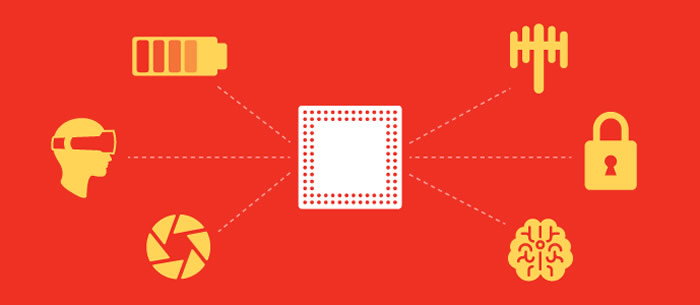Chip from Qualcomm to hit many high notes for mobile power users
Qualcomm appears to make a lot of device wishes granted. A processor designed for long battery life, virtual reality sessions, nice camera capabilities, and great download speeds. Coming up the pike will be the Snapdragon 835 processor.
In short, the benefits include good tidings for performance, battery life and cameras.
The battery life angle will no doubt be highlighted as the chip’s strong point but Jon Fingas in Engadget reminded readers that the 835 “also carries a ton of upgrades that reflect a rapidly changing mobile landscape.”
Take virtual reality. “On top of 25 percent faster Adreno 540 graphics, it improves positional audio and reduces the lag between motion tracking and what you see on-screen. You won’t be as likely to feel seasick or turn the wrong way, in other words.”
Abhimanyu Ghoshal in TNW talked about the chip too, saying “the faster processor will reduce motion tracking latency in VR experiences, which should make headsets less strenuous to use. The 835 will also allow for better positional audio for more immersive sound.”
Funny. Remember when we used to use phones for phoning? Francisco Cheng, Director, Technical Marketing, said Tuesday on the Snapdragon blog talked about our present-day expectations. He said, “we expect our batteries to last. We expect our processors to handle new apps and games. We expect our cameras to take pro-level pictures and videos. In bad light. At a rock concert. We’ve come to expect a lot from our phones. We’re power users.”
Cheng said Snapdragon 835 uses “a new 10nm design with more than three billion ultra-efficient transistors.” He said it is 35% smaller than its predecessor, the Snapdragon 820.
“This pivotal size reduction and efficiency boost allow device manufacturers to design thinner premium-tier consumer devices (smartphones, VR/AR head-mounted displays, IP cameras, tablets, mobile PCs, and more) with larger batteries that run on less power and last longer.”
How does it bring good things for VR? Cheng talked about the VR advantage: “Designed to meet VR processing demands within strict thermal and power constraints, the processor offers 25 percent faster 3D graphic rendering and 60X more display colors when compared to the previous generation.”
Cheng said Snapdragon 835 supports 3-D positional audio, superior SNR (Signal-to-Noise ratio), and native DSD format support for true high fidelity playback.
The SoC was engineered to produce a 20% reduction, versus the Snapdragon 820 as implemented in the VR820, in motion-to-photon latency and six-degrees-of-freedom (or 6DOF) for precise, comfortable, and intuitive motion tracking.
Cheng moved on to Snapdragon 835 features vis a vis fast Internet speeds. “Snapdragon 835 is the world’s first solution, supported through the companion WCN 3990 chip, to be certified for Bluetooth 5.0, improving overall speed, range, and capacity. This powerful combination of advanced LTE technologies as well as state-of-the-art Wi-Fi connectivity work together to support blazing fast speeds virtually anywhere you go.”
As for location services, he said Snapdragon 835 is engineered to deliver an up-to 30 percent improvement in accuracy for indoor navigation compared with Snapdragon 820, and up-to 50% reduction in power compared to traditional GNSS.
What’s the news on dates? Cheng said, “The first announced Snapdragon 835 powered devices are ODG’s R-8, the company’s first consumer mobile AR/VR smartglasses for early adopters, and the R-9 for wide field-of-view (WFOV) experiences—from light enterprise to prosumer media consumption. Both are expected to be available by the second half of the year.”
As the Engadget subhead said, “Say hello to the mobile processor that will define 2017.”
More information: TechXplore


Comments are closed, but trackbacks and pingbacks are open.